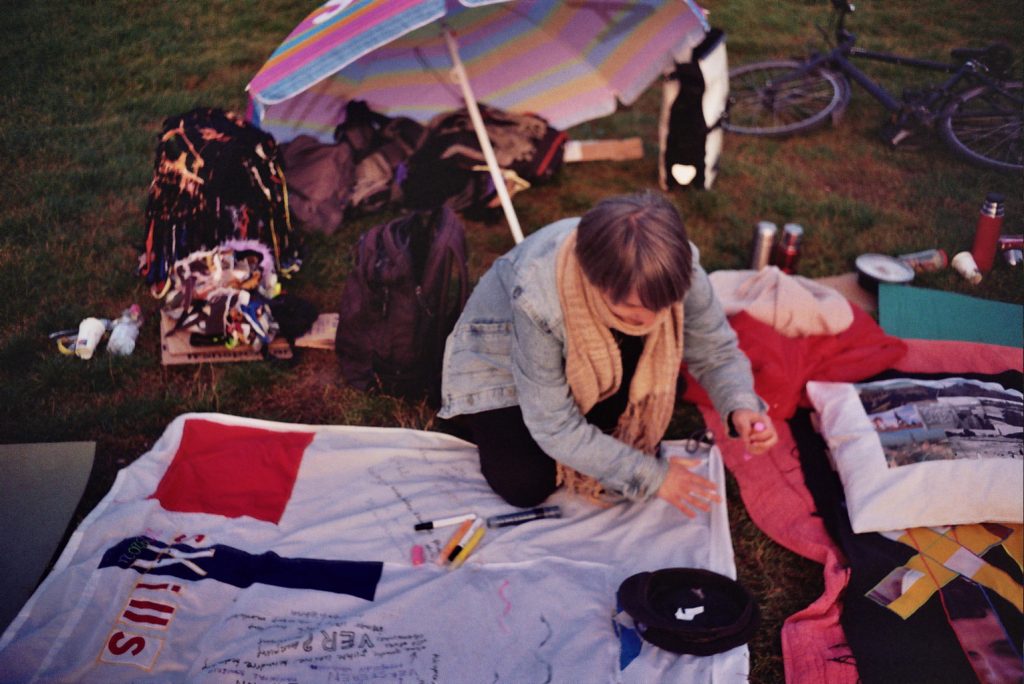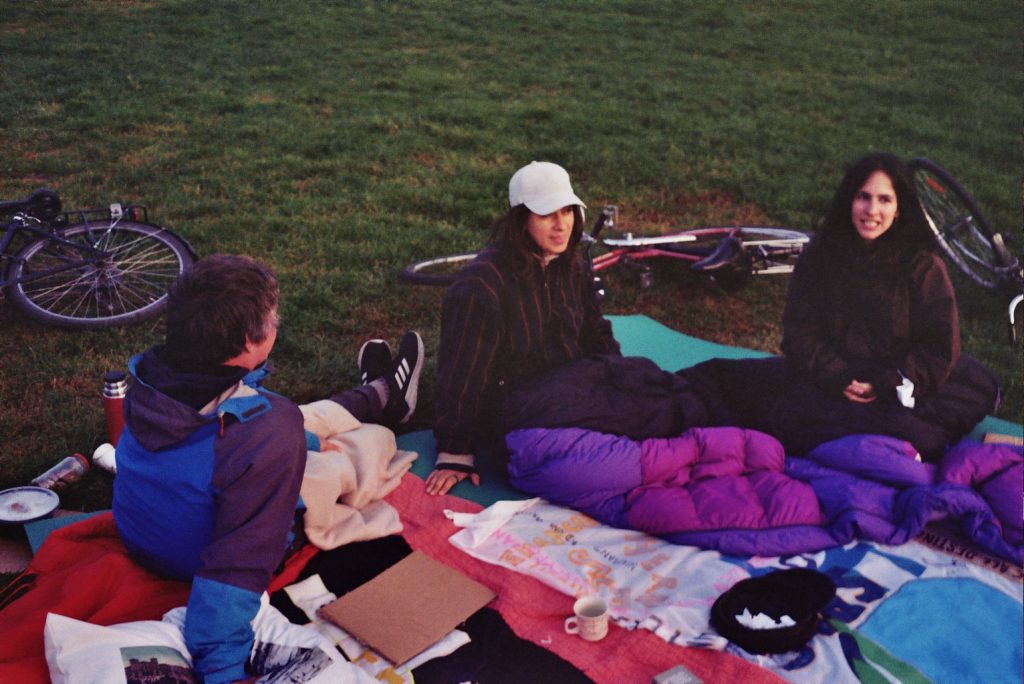
Há também uma versão portuguesa deste artigo.
The aim is clear: to “work” on something together with participants and the park’s visitors, so that a “break” would be possible. Work must precede the break as “Arbeitspause” is different from the English phrase “work break.”
Inspired by the academic concept of commoning, Sala co-hosted the first round of events at Berlin’s Görlitzer Park (nicknamed Görli) with different topics for five actions: Common Ground (2nd of September 2021), Common Skills (23rd of September), Common Surviving (25th of September), Common Nap (30th of September), and Artists’ Commons Parade – Feierabend (9th of October. Feierabend means the end of a workday in German).
Sponsored by Berlin’s Bezirk Friedrichshain-Kreuzberg (Friedrichshain-Kreuzberg District Administration) and Landeskommission Berlin gegen Gewalt (Berlin against Violence, a Commission of the Berlin State), Arbeitspause im Görli attained another layer of meaning: to diversify Görlitzer Park’s usage and to enhance Berliners’ social engagement in the park. The initiative is significant as Görli is one of the few parks in Berlin where somewhat-tolerated, somewhat police-threatened drug dealers and patrolling police officers tenuously co-exist.
In this particular context, a complex constellation of participating artists doing something together took place, concretising several academic theories and carrying out tasks such as interacting with fellow artists, guests, or random passersby. Being mindful of social and intellectual inclusiveness was constantly in question.
The following dialogue was conducted between myself and Marta Stanisława Sala after the very first action. Common Ground was a reading session in which organisers and participants from different cultural backgrounds and with different first languages faced the problem of translation and the thorny question of language hierarchy in academia (and thus, the hierarchy of ideas). In this dialogue, now reproduced in the written form of an interview, Sala fulfilled her genuine wish to break the collective isolation that many people including artists—have been facing until now, not only during but also before the COVID-19 pandemic.
This article was originally published in 2021 by BUALA, a decolonial publishing platform in Portuguese. A translation of the same dialogue was published in Taiwan’s art magazine “Insular City Zine” (Taiwan-Chinese-Mandarin version) and in Hong Kong’s “The News Lens” (Hong Kong-Chinese-Cantonese-Mandarin version) with the English title: “‘Break’ and ‘work’: a short discussion on ‘Arbeitspause’ with Berlin-based artist Marta Sala.” (More recently, a Portuguese version follows.) After these publications, Sala invited me to be an active participating artist and visual anthropologist for the project, for which I was granted the status of “freelance artist” and “freelance anthropologist” by the Berlin Immigration Office (Landesamt für Einwanderung).
The abovementioned collective isolation touches many: both insiders and outsiders in many different areas. I humbly hope that this interview, which was kindly proofread by American writer Dayoung Lee, could become part of the many Berlin voices dedicated to collective, global action, regardless of form or our different backgrounds.

The project seems to be a direct reply to the Corona crisis, lockdowns, and the subsequent existential questions raised for all, including artists. The phrase Arbeitspause (literally “work break”), in German is very ambiguous. For some, it could mean a sort of leisure. For another, it could also imply unemployment. What brought you to this project and how do you work this Pause as Arbeit in order to simultaneously enhance your creative and artistic productivity and raise awareness of the importance of breaks?
First of all, I would not say that it is a reply to the crisis, but rather an attempt to do something for the good of the community, for the common, or its commoning. I have had luck and privilege to experience Corona not so much as a crisis in its literal sense. Many would also agree with me as we live in Berlin, a relatively rich city where some of us had such privilege, or even luxury, to stay safe and calm.
Furthermore, one needs to define or even redefine what a Pause means in this particular context of artistic practice. After all, this German expression is Arbeitspause. Pause is subject to Arbeit, a break from work, Arbeit temporally, spatially and emotionally defining Pause. It thus also raises the question whether this artistic project or artistic work in general is Arbeit at all? As very often artistic work is not considered to be something serious.
Here, in German, work as passion or love or a profession gives a large room for interpretation. The term Reproduktionsarbeit (literally “reproductive occupation,” but meaning, e.g., parenting) might illustrate the openness very well. Moreover, given the interchangeability of “work” in an artistic context with, for example, the “work” from “housework” or even “love,” such comparisons with productivity, even as the connotation comes with the word “work,” seem to me dangerous. For example, when we observe love as work, how much would it cost for a mother’s hug or intimacy with someone you love?
Another question is, how people were able to afford this Pause during the pandemic. Since its meaning varies in each particular personal context, Pause from work could be a personal catastrophe or leisure, to use your word. With the official and bureaucratic status of “artist,” I was financially supported by the German federal government during the lockdown. But the emotional breakdown, provoked and sustained by social isolation—and I should repeat that we are privileged to worry about not much more—has proposed a need to rethink not only what work or Pause is in an artistic context, but also what Freizeit (free time) is. Art is not about creating alone and then consuming alone. It is a sort of social life; it is about the social actions between the creator and the consumer.
Thus, we are here to work with the community in order to create a Pause that in turn generates this Work-Break circle.

In the European linguistic context, Arbeit (German), praca (Polish), and work (English) seem to me as much ambiguous as in Cantonese, for example, in which 工夫 does not only refer to a labour-money exchange. Back in the European linguistic context, it seems to me that work, involving money or not, is an exchange of labour for a certain compensation. Even when one talks about love—both exclusive and polyamourous relationships—the word “work” can be used to describe non-monetary exchanges. In this particular sense of “work”, with all its ambiguity, what is the meaning of Pause? This question has been troubling me since I was thinking in an exclusive way, with Pause as a part of work and pauses enhancing productivity.
I think in some sense, the English word “break” or the Polish przerwa makes it clear that to pause is also to break (something). If we talk about it etymologically, I can continue to romanticise the link with “breakdown”, such as the emotional breakdowns that I had, as many others did, during several hard lockdowns. As I said, art-making is a social life, composed of social interactions that we need to urgently gain back even before the complete end of the pandemic—if that is possible at this point.
This project is, therefore, enabling the meeting and exchange of these various thoughts, considering what a break may be, as well as catalysing an artistic creation or reaction to the meanings related to pleasure or rest. If I speak in a selfish way, all the Corona measures have been making indoor art presentations virtually impossible, and thus the project is also driven by an existential concern for us artists who need human contact not only on the emotional level but also on a very practical one. But somehow the project presents a very good chance for us to rethink the theories on how to utilise existing public or semi-public spaces for an artistic—or to say it more directly, professional—purpose.
In this sense, Gemeinschaffen, or in English “commoning,” is to be practiced in its most literal sense: to do something together. Together with Costanza Rossi from Chile, Johanna Reichhart from Germany, Marcos García Pérez from Spain, and other local and international participants like my sister Katarzyna and you from Macau. We managed to make this Pause happen, especially in this sense of a break which is subject to work. Without work, Pause would not make sense. We have different artistic concerns in theoretical terms and practical skills if we speak about our art, like textiles in my case. But the main thing is to take time, to work together, to reflect together on the process, so that a Pause becomes possible.
Let us then continue in the future to discuss important theoretical and practical aspects of this ongoing artistic practice of commoning. Dziękuję!
With pleasure, dziękuję too!

Text and images by Cheong Kin Man.
Arbeitspause works in collective structures with artists and cultural workers. In the summer of 2021, an initiative with the same name was launched by Marta Stanisława Sala and Johanna Reichhart as a direct response to the increasing precarity of artists during the pandemic and as an urge to turn “being alone together” into “doing something together.” Five artistic actions, “Arbeitspause im Görli”, took place at Görlitzer Park. The origin of this can, however, be traced back to 2018, when the two artists, together with Marcos García Pérez and other fellow students, performed 24 hours of commoning at the Berlin University of the Arts as part of the “40 Years of Art in Context” exhibition. Last year, the collective held its first exhibition “Utopian interventions in Tempelhof’s landscapes” at Berliner Genossenschaftsforum with 26 international artists and filmmakers.
Katowice-born and Berlin-based Marta Stanisława Sala has long been working in collaboration with her fellow artists. Following fifteen intense years of life of art and social actions in Krakow (2000-2015), where she graduated in painting at the Academy of Fine Arts, Sala studied Art in Context at the Berlin University of the Arts with a DAAD scholarship (2017-2020). Besides painting and textiles, she deals with politically and socially engaged cultural animation and interdisciplinary art projects. Her recent projects include the Jewish remembrance culture project “Esther’s Willow” in her hometown Chrzanów and a series artistic action on Utopian language with Cheong Kin Man. Her works have been presented at Ujazdowski Castle, Le Guern in Warsaw; Galicia Jewish Museum, Bunkier Sztuki in Krakow; Temporary Gallery in Cologne; SAVVY Contemporary in Berlin; KUB in Leipzig; among others.
Cheong Kin Man is a PhD student in Visual and Media Anthropology at Freie Universität Berlin and cultural correspondent of Portuguese newspaper Jornal Tribuna de Macau in Central Europe. A former government translator and interpreter and occasional curator since 2008, he writes in Chinese, English, French, German and Portuguese and publishes in Macau, Germany, Hong Kong, Portugal, Réunion or Taiwan. His award-winning experimental visual ethnography “a useless fiction” (2015, 2023) has been presented in over 40 countries and territories. His works have been presented at Museu do Oriente (Portugal), Yilan Museum of Art (Taiwan), and in film festivals like Festival de Cine de Bogotá, Duisburger Filmwoche, Singapore (SGIFF) and China Independent Film Festival. As part of the Arbeitspause collective, he has been working intensively with Berlin-based Polish artist Marta Stanisława Sala since 2021.





